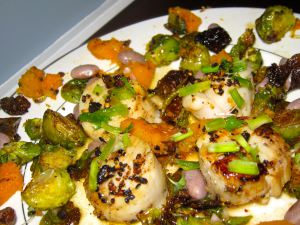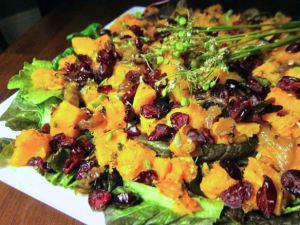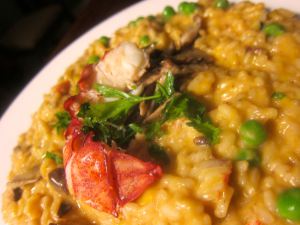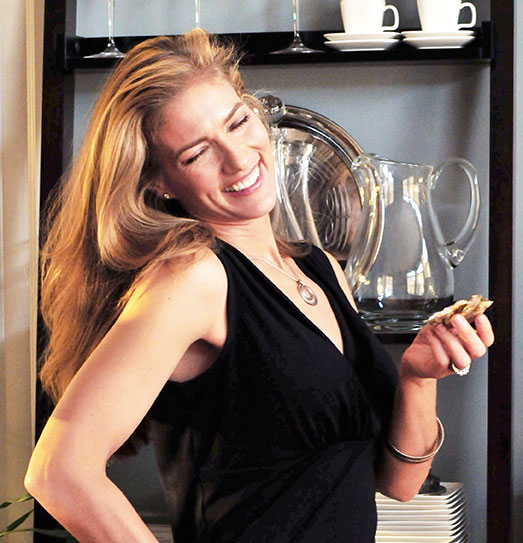Monday, November 28, 2011
 Eating locally brings different vegetables and fruits to your table almost weekly, stimulating ideas for creating new recipes and providing the opportunity to cook seasonal favorites. There are so many uses for winter squashes, both savory and sweet, and I’ve really been enjoying using these vegetables in lots of fun ways this past month. My pumpkin whoopie pies prepared with fresh pumpkin and filled with buttercream made with local maple syrup were outrageous. I also made a Thai-inspired, velvety pumpkin soup with roasted cashews, curry, and coconut milk over the weekend to send to my sister. (Here’s the video.)
Eating locally brings different vegetables and fruits to your table almost weekly, stimulating ideas for creating new recipes and providing the opportunity to cook seasonal favorites. There are so many uses for winter squashes, both savory and sweet, and I’ve really been enjoying using these vegetables in lots of fun ways this past month. My pumpkin whoopie pies prepared with fresh pumpkin and filled with buttercream made with local maple syrup were outrageous. I also made a Thai-inspired, velvety pumpkin soup with roasted cashews, curry, and coconut milk over the weekend to send to my sister. (Here’s the video.)
Squash aside, it occurs that it’s been awhile since I’ve written anything about fish, which is a bit odd given it’s one of the major protein foods I consume. Now is a good time to return to this topic, as I recently had a class dedicated to seafood. In the next few weeks I’ll address some of the complexities, from farm to fork, including nutritional aspects as well as sustainability. Of course I’ll post some delectable meals as well, like today’s dish. (To whet your appetite about a few others coming soon: pan-fried bluefish with shiitake mushrooms, beet greens, and two sauces; steamed mussels with white wine, garlic, and shallots; tuna tartare with avocado and sesame…)
I can already tell I’ll have nothing funny to say about today’s scallops, though. Ah, well. As I’ve said, food and science aren’t always funny, despite my best efforts.
Here’s how I did it.
Roast the winter squash. I used one sugar pumpkin and one butternut squash, but you can feel free to use only one variety, or another kind of squash if you prefer, such as acorn. The preparation is pretty much the same, and here’s a video to show you how. Wash the squash, cut in half, and remove the seeds. (Set the seeds aside if you’d like to roast them and use them for another purpose.) Next, coat the cut sides of the squash with a bit of olive oil and a sprinkle of salt and freshly ground pepper. Place cut side down and roast in an oven at 425 degrees 30-45 minutes. The length of time will depend on the thickness of the squash flesh; butternut will take less time than pumpkin, for example. Poke the squash with a sharp knife after 25 minutes; if it enters easily, it’s done. Set the squash aside until cool enough to handle.
Make the maple-scented squash purée. Scoop about 2 cups of the squash flesh into a food processor or blender; you can also use a hand masher, if you prefer a chunkier texture. Blend until smooth. Heat a tablespoon of olive oil in a medium pot. When hot, add a clove or two of crushed garlic and sauté until fragrant. Add the squash purée and stir until combined. Mix in a teaspoon of maple syrup (or more, depending on the size of the squash). Taste, and adjust the sweetness as desired; it will depend on which squash you used. Despite its name, butternut squash is quite a bit sweeter than “sugar” pumpkin. Season with salt and pepper. Turn off the heat until you are ready to serve the dish, then simply reheat at medium-low heat; make sure to stir once in awhile so the bottom doesn’t burn.
Create the spice mixture for the scallops. Mix together one teaspoon each of cumin, chili power, dry mustard, garlic powder, and sugar along with 1/2 teaspoon of white pepper (or black) and sea salt. Add a pinch of cayenne if desired. This is a dry spice rub I use on lots of fishes that I sear, which creates a luscious sweet-spiciness and adds beautiful color and caramelization. (See the picture?). I absolutely love it. If it’s your first time making it, know that it could take time to get a mix that you prefer. For example, you could omit or reduce the amount of sugar, salt, and pepper, especially if you are a super taster. (Super tasters are more sensitive to big flavors, as the name implies; it’s a real physiological phenomenon.) If you don’t feel like making the rub, dont have the spices on hand, or whatever, you can just season the scallops with salt and pepper and sear them in hot olive oil. Fish is always delicious prepared simply, especially when served with sweet squash. The flavors won’t be the same and you won’t get the same spicy-sweet crust, of course, but it will still be a lovely dish.
Sear the scallops. Searing fish is a fairly quick process, though of course it varies by thickness. I used local New Bedford sea scallops, which are ridiculously sweet and tender. Here’s a good time to mention that this dish could be prepared with any number of fishes; white fishes such as halibut, hake, bass, haddock, and cod work particularly well. Salmon is another option, though its flavors are bigger than the milder white fishes. Heat a few tablespoons of olive oil in a pan or skillet at medium-high heat. Dip the top and bottom of the scallop into the spice mix, then place in the skillet once the oil is hot. Cook for about 3-4 minutes, then turn over. If your scallops do not have a beautiful brown crust on them, you need to turn up the heat and give it another minute of so. Cook the second side until it looks the same. I like my scallops medium-rare, so if you like yours cooked through you will need more time. You might consider experimenting with one scallop first, perhaps even cutting it to see if it’s cooked enough for you. Cooking fish is actually remarkably easy, but the key is to avoid overcooking, which will lead to dry, tough, flavorless fish. (I’ll have to get a video of me cooking fish up here soon to help you out.) When the scallops are cooked, remove them to a plate to rest and cease cooking. This should be about 3-5 minutes before you plate the meal.
While the scallops are resting, sauté the radish greens. So many vegetables that you consume come with leafy green tops that are incredibly flavorful and loaded in nutrients. Do not throw that nutritious food down the garbage disposal! All you do is cut off the greens, let them soak in a small bowl of cold water to remove any sand or dirt and rehydrate them (if necessary), then toss them onto a dish towel to dry. (Or use a salad spinner.) You do want the greens to be dry, otherwise they will steam rather than sauté. Never tried radish greens since you hate radishes? No problem. Try beet greens, mustard greens, or spinach (even if from a bag). What we are looking for at this point is to add contrasting flavors, because both scallops and squash are on the sweet side, as well as texture and nutrition. Heat a bit of olive oil at high heat (not the highest), add a clove or two of crushed garlic, throw in the greens, and sauté until almost limp. Add a few drops of balsamic vinegar and mix. (Note: Greens cook very quickly, in about 2 minutes.)
Plate the dish. Spread some of the squash purée on a plate and top with 3 or 4 scallops. Artfully strew the greens around the scallops. Serve immediately.
See? Nothing entertaining about this dish. (Sigh.) Delicious: yes. Funny: not so much.
An Aside: Adding Crunch and Texture (or Not)
I love to toast pumpkin and squash seeds and use them to garnish lots of things, mainly soups and salads. Adds fiber, texture, and crunch. Plus, I love using every part of the vegetable, whether it’s including the skin in a roasted eggplant dish or the leaves of a humble root vegetable like radishes in today’s dinner. In the vein of “this is real life, not the food network,” I’d like to take this opportunity to tell you about something that didn’t work quite as well for this dish, in my view. I use toasted nuts in lots of dishes so I thought this would work well, but I wasn’t a huge fan. Cooking is a creative process, and experimentation is the key: I plated two dishes, one with and one without seeds to figure out what I liked. Who knows? Maybe you’ll prefer the one with the seeds, hence this aside. It occurs that toasted pine nuts could also work here, which are more tender than pumpkin seeds…
Nevertheless, my point is that, like you, I’m always learning. And that’s what keeps things fun and interesting, especially if we’re in it together.
—
If you like what you see here at The Nutrition Doctor is In the Kitchen, please subscribe to my blog from the home page, become a fan on Facebook, follow me on Twitter, check out my food porn on Pinterest, watch my videos on YouTube, and peruse my recipe page for soups, salads, seafood, sweets, and more. Thank you for reading!
 Dr. P. K. Newby is a nutrition scientist and educator with expertise in the prevention of obesity and chronic diseases through diet and the relations between agriculture, food production, and public health. She brings together her passions for food, cooking, science, and sustainability through her writing and videos to help people eat their way towards better health, one delectable bite at a time.
Dr. P. K. Newby is a nutrition scientist and educator with expertise in the prevention of obesity and chronic diseases through diet and the relations between agriculture, food production, and public health. She brings together her passions for food, cooking, science, and sustainability through her writing and videos to help people eat their way towards better health, one delectable bite at a time.
© 2011 The Nutrition Doctor is In the Kitchen. All Rights Reserved.





I haven’t read this post yet, but that photograph looks freakin’ incredible. I wish I was having that for dinner! Have to try out your recipe.
Thanks Cat :). Let me know what you think…